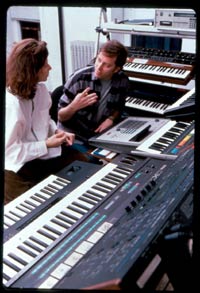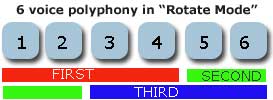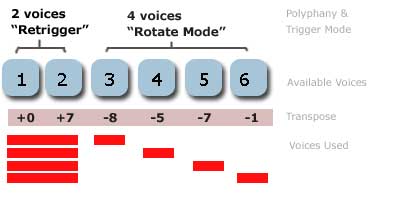The Rotator: A Realtime Harmonic MIDI Processor
“Boure”
 As a kid, I learned to play folk guitar during the early sixties, and I’d experimented with a number of “open tunings”. Though I knew a couple of standard tunings used for bottleneck blues and such, I didn’t take much notice until I started listening to Joni Mitchell.
As a kid, I learned to play folk guitar during the early sixties, and I’d experimented with a number of “open tunings”. Though I knew a couple of standard tunings used for bottleneck blues and such, I didn’t take much notice until I started listening to Joni Mitchell.
So I thought, “What if you could do the same thing on keyboard?”
Back in the mid eighties, Maz & I decided to combine our two studios into one massive keyboard/programming room which came to be known as “The Lab”.
As we were both keyboard players, our combined arsenal at one point reached close to 30 synthesizers! Somewhere in that pile of gear was a six voice digitally controlled analog synthesizer made by Oberheim known as the Xpander.
Architecture
I could do a whole blog on the architecture of the Xpander and how revolutionary it was (and still is!), but the thing that immediately fascinated me about this instrument were two features I had never seen on any other synthesizer.
In The Zones
Each of the Xpander’s six voices could be assigned to one of three “zones”. In turn, each of the three zones could be assigned to a unique midi channel. I’m sure the designers primary intention was to allow you to split the keyboard and have up to three different sounds being triggered simultaneously. (Remember, in 1985, midi was in it’s infancy, and the notion of networking a number of keyboards together under the control of midi sequencers was still pretty exciting.)
Trigger Modes
The synth’s designer, Tom Oberheim, also included an elegant way to select how each of the zones would respond to midi triggers. The trigger settings for the zones (if memory serves) were…
- Retrigger each note retriggers all voices assigned to the zone (essentially making the zone monophonic)
- Highest incoming midi steals the highest note
- Lowest incoming midi steals the lowest note
- Oldest incoming midi steals the oldest note
- Rotate incoming midi rotates through the available voices assigned to the zone one by one.
This last one was by far the most interesting to me. Now with this crazy new keyboard and it’s ability to tune individual voices and rotate among them, I thought it might be possible to create and “open tuning keyboard“!
Open Tunings
So I thought, “What if you could do the same thing on keyboard?” Happily, by retuning certain voices a new set of chords began to emerge. It sounded a bit like Aaron Copland.
“Auto-Aaron”
Of course, just like open-tuning guitar, only certain chords work in a particular tuning, but the experimenting became half the fun.
The feature that made this sound so markedly different from merely tuning parallel oscillators as you might on a Prophet V or other more traditional synth, was the rotation of voices.
Here’s how it worked:
Imagine a four note chord played three times. Because only four of the six voices are played…
The first time: 1-4 play
The second time: 5, 6, 1 and 2 play
The third time: 3, 4, 5 and 6 play
Now of course, it’s unlikely that you’ll have nothing but four note chords. In fact, you have lots of different chords and some single lines thrown in as well. Which voice a chord starts on depends on what came before. As only some of the voices might be transposed in a particular tuning, the resulting harmony and transpositions were almost always surprising and unpredictable. It was, in many ways, similar to the Enigma Machine – the famous rotating substitution coding device used by the Germans during World War II.
Michael’s Mod
This was about the time that I met the insanely telented Michael Brecker. At that time, he’d been playing with Steps Ahead (we met during the recording of their album “Magnetic”). Michael was also working on his first solo album.
Mike was a big fan of the Xpander which he used with his Steinerphone (an early electronic wind instrument (EWI) designed by Niles Steiner). I set up a couple of open tuning patches on his synth and didn’t think much more about it until several weeks later at a recording date at the Power Station. Michael had taken the open tuning idea into a really interesting and unexpected direction.
By using two “zones” – one set to retrigger and the other set to rotate, Michael had coerced the Xpander to output a three-note chord for every one note of input.
Input: play in “middle C” four times
Voices 1 and 2: always play a parallel 5th [C, G]
Voices 3,4,5,6: play in rotation (D, F, E, B)
Output: [DCG], [FCG], [ECG], [BCG]
The diagram above is just one possible tuning, but the result is often surprising. In this example, a simple piano melody is mangled towards Monk.
“N.Y. Minute”
To hear what Michael was doing with it at the time, listen to “Original Rays” on the “Michael Brecker” album.
 Getting Out of the Box
Getting Out of the Box
So I’ve messed around with this notion of rotating substitutions since then, but was always frustrated that, because of the Xpander’s lack of midi output, I wasn’t able to trigger anything else in this manner. That is, until I stumbled onto Max.
Max is a visual programming environment which allowed me to basically reconstruct (and extend) the Xpander trick as a midi bus plug-in.
Now, (at least on the mac) any midi “in” could be processed using this rotating algorithm. And best of all, I now had control over the polyphony of the input and output. I can also save up to forty “patches” which include parameters fortuning, volume, velocity scaling and midi channel.
Here are a couple of variations using the Rotator algorithm on the melody from Freedom Jazz Dance. The input is never more than two notes simultaneously. The output is usually six notes at once. Because there are two completely separate instances of the Rotator algorithm running, the second note can be in a completely different part of the tuning cycle. The result is, the exact voicings almost never repeat, yet they are always recognizable as “having that sound”.
“Freedom Stick”
“Freedom Band”
Is this stuff cool or is it just me? I’m convinced there’s an amazing record to be made with some live playing through this slightly cyborg-like harmonic extentionator mixed with natural musicians and some orchestrations possibly based on the output. It’s a bit like Monk meets William Gibson. Computational Miles. Yeah. “In a Cyborg Way”.
Someone likened it to wearing “musical stilts”. It creates harmonies and substitutions that are logical but nearly impossible to calculate on the fly unaided. By using a computer to do the math, and using your “ears” to try and keep up with the unexpected harmonic feedback-loop this toy provides is some of the most fun playing I’ve had in recent years.


